Abstract
The concept of time-space continuum as to depict a dimension in the 356 multidimensional cosmos has been discussed. It is explicated that these dimensional time-space continuums may be graphically represented as layers or energetic boundaries trapped between consecutive nested spheres much like the ‘Matryoshka Russian Dolls.’ In order to cross and traverse a particular dimensional layer one has to resonate with the particular frequency of that time-space continuum referred to as its ‘threshold frequency.’ So, in this regard, the time and space are considered as measures that describe the ‘in-layer’ coordinates of any entity within a given dimension, while frequency describes the ‘out-layer’ coordinate, which by changing it, it defines its propensity to move out of the dimension. It is explicated that analogous to the position vector, frequency also describes the inverse of the time function. A more simplified planar graphical representation of the space-time continuum is proposed in which a particular dimension may be represented as a unit vector in such a plane composed of frequency as ordinate and time as the abscissa. The dimensional designation is defined as the angle this unit vector makes with a reference coordinate such as the time axis, measured in radians or degrees as an integer number of 1 to 356. Five distinct zones are identified within such a planar space-time representation that include the ‘time zone,’ the ‘frequency zone,’ the ‘neutral zone,’ the time-dominant zone,’ and the ‘frequency-dominant zone.’ Physicality is seen to occupy a very narrow regime within the time-dominant zone, where the notion of time is more significant, and where multidimensionality is highly confined or not readily accessible. On the other hands, the frequency-dominant zone is comprised of a multitude of higher dimensions capable of ‘seeing through’ the lower ones, with multidimensionality being highly prevalent. Furthermore, 4 distinct quadrants may be identified in the planar depiction of time-space continuum, each containing 89 distinct dimensions. It is further elucidated that only one quadrant may be considered when describing the time-space continuum with the other three quadrants being the mirror image of others either in terms of time, or space, or both.
Introduction
- As it will also soon be demonstrated, one can distinguish among 356 time-space continuums [1].
- We can consider each dimensional time-space continuum to occupy a given domain in the cosmos [2].
- Each distinct time-space continuum is called a ‘dimension.’
- To travel from a dimensional time-space continuum to another, one has to change or adjust a measure or a quantity called ‘frequency.’
- Thus, there exists a distinct frequency associated with each and every dimensional domain or time-space continuum.
- An entity is said to occupy a particular dimensional domain or a time-space continuum when its natural frequency matches the frequency (referred to as the threshold frequency) associated with that dimension [3].
- It is then said that the entity resonates or vibrates in that dimensional domain or continuum of time and space.
- The natural vibrational frequency of a given entity is equal to the square root of a parameter called coefficient of consciousness expansion to its constitution [4-5].
- When an entity is a physical being, its constitution is equivalent to the mass of the body of that being.
- Mass is a quantity describing ‘matter,’ which depicts the particulate essence of the being that has been compacted.
- And, the degree of compaction of the mass in space gives rise to another measure that is called ‘density,’ which is defined as the mass per unit volume of the space that the matter occupies.
- Alternatively, when we speak of the vibration of an ethereal entity, its constitution is none other than its antimatter [6].
- An incarnate constitutes antimatter in matter.
- And, when we speak of an incarnate constitution, we refer to its mass again, as it is the physical mass of the body, which is of concern to the vibrational natural frequency of the body [7].
- Furthermore, the coefficient of consciousness expansion is a constant that defines the entity’s resistance to accumulation of karma, a measure for the negative or evil deeds that the entity has committed in its entire history of existence [8].
- This history is commonly stored in the body of the soul, which it occupies in antimatter.
- And, when we speak of karma with regard to an incarnate, it is the extent of such energies that has been stored in the soul animating the body.
- ‘Frequency’ depicts the rate of change of the dimensional angle that a dimensional domain or a time-space continuum subtends from a given plane of reference in the cosmos.
- In term of holographic sub-dimensional layers within a main dimensional plane (e.g., the 3rd dimension), although both entities have the same frequencies they project on different (holographic) planes that are distinguished from one another through definition of what may be referred to as the ‘phase angle.
- When you change this projection angle, when compared from one sub-dimensional domain to another, it is said that a ‘phase change’ has occurred.
- Alternatively, it is said that the distinct sub-dimensional domains or time-space continuums are ‘out of phase’ with one another.
- In terms of vibration mechanics if an entity resonates with one sub-dimensional domain, and another being vibrates in another sub-dimensional time-space continuum, it is said that the two entities are (or vibrate) ‘out of phase’ with (or from) one another.
- The two entities vibrating out of phase in distinct sub-dimensional domains (or time-space continuums) cannot physically interact with one another [9].
- Furthermore, THE ‘LAW OF DIMENSIONAL CONSCIOUSNESS SHIFT’ INDICATES THAT A HIGHER DIMENSIONAL ENTITY HAVING A HIGHER THRESHOLD FREQUENCY CAN ‘SEE THROUGH’ THE LOWER DIMENSIONS BUT THE OPPOSITE IS NOT TRUE, THAT IS, HIGHER DIMENSIONS ARE STEALTH TO THE LOWER DIMENSIONAL BEINGS [10].
Graphical Depiction of Diverse Dimensions or Time-Space Continuums
- A time-space continuum that only expands or contracts in time may be represented by a vector depicting space and a ‘radial’ scalar quantity representing time.
- The position of an entity (point) in space can be adequately described by a vector extending from a reference point in space, called the origin, to the point in question.
- This constitutes a vectorial quantity that has two features: magnitude and direction.
- While magnitude can be described by a scalar quantity composed of a single measure, the specification of direction is much more complex, which defines the very essence of a vectorial quantity.
- A vectorial quantity can be represented by three distinct angles each identifiable by a distinct scalar measures (either radians or degrees).
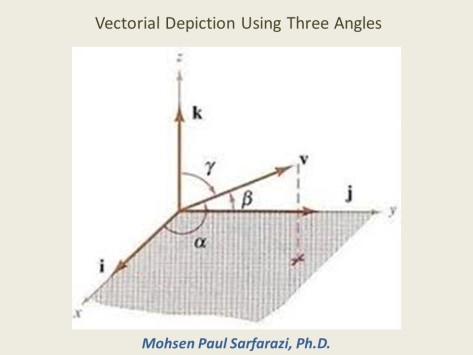
- These angles are defined as three distinct angles that the vector makes with respect to a set of mutually orthogonal Cartesian coordinate axes, each being perpendicular to one another.
- Therefore, a vectorial quantity is equivalent to specification of a set of 3 distinct scalar measures.
- An alternative approach in defining such scalar measures is to consider the projection of the vector in question on a set of three mutually perpendicular coordinate planes definable by two (among the 3) mutually perpendicular coordinate axes independently.
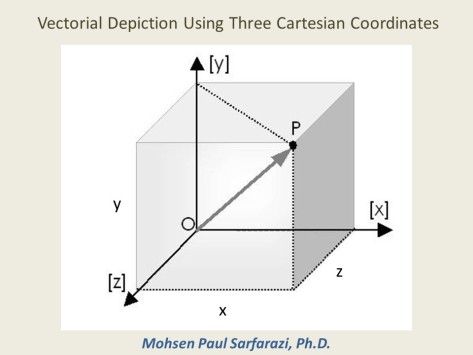
- This is often referred to as the ‘planar’ coordinates for short.
- The scalar measures thus defined are depicted by ‘length,’ ‘height’ and ‘depth,’ which are represented by the distance from the origin to the point of projection of the vector on a particular axis, which are commonly denoted by the x, y, and z coordinates.
- The locus of the end point of the vector in question describes a spherical domain in the space.
- A time-space continuum, on the other hand, may be defined by attaching or assigning another scalar measure (time) to such a spherical domain.
- It involves space as a vectorial quantity, which is depicted by the aforementioned position vector having a certain radial magnitude, and a scalar quantity that describes the expansion of the sphere in a direction perpendicular to the surface of the sphere (along the ‘radial’ position vector).
- A time-space continuum, therefore, can be illustrated by a set of nested layered spheres that like ‘Matryoshka Russian Dolls’ contain one another.

- Every layer, which describes the boundary between two consecutive spheres having a finite thickness is called a ‘dimension’ or a time-space continuum.
- These boundary layers actually have an energetic aspect associated with them.
- In order to traverse from one dimensional layer or a time-space continuum to another one needs to first overcome the barrier having an energetic threshold associated with it.
- From the mechanics or physics point of view, each individual layer is comprised of a threshold energetic field that exerts a resistive or repulsive force against entry to such dimension or time-space continuum, which must first be overcome.
- And, in order for an entity such a particle or a being to be able to vibrate in a particular dimension or time-space continuum, THE ‘LAW OF FREQUENTIAL RESONANCE’ INDICATES THAT THE NATURAL FREQUENCY OF THE ENTITY MUST FIRST MATCH THE FREQUENCY OF THAT DIMENSION SO IT CAN VIBRATE SYNCHRONOUSLY AND HARMONIOUSLY IN THAT TIME-SPACE CONTINUUM [10].
- Note that the vectorial measure of space depicting a particular sphere and the ‘radial’ scalar measure of time representing its expansion in an orthogonal sense represent a conjugate pair that define every dimension.
- And, time and space are inverse of one another.
- Thus:
s = 1/t
- Where the bold letter depict a vectorial quantity.
- The energetics of a particular dimension may be described as the area under the curve created by plotting space versus time or vice versa.
- And, dimensional energy is a scalar quantity that is thus formed or defined.
Planar Representation of a Time-Space Continuum or Dimension
- Let us consider a set of planar orthogonal Cartesian coordinate axes with time as abscissa and a measure of space as the ordinate.
- For the sake of argument, space may be considered as x, y, or z coordinate for simplicity or as it will become obvious, alternatively, frequency may be considered to depict space.
- Note that the concepts of space and frequency are equivalent in this respect that either depicts confinement within the aforementioned sphere with time representing the out of surface expansion of the sphere in a ‘normal’ or perpendicular sense.
- Therefore, one can either specify ‘space’ or ‘frequency’ to represent the conjugate of time in the time-space continuum description of cosmos.
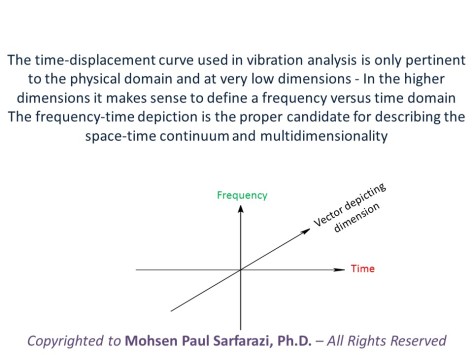
- And, let us deliberate that a dimension may now be depicted as a domain defined by a normal unit vector that is perpendicular to the surface of the sphere.
- Let us now consider a planar depiction in which time is the abscissa and frequency the ordinate.
- In this planar depiction of time-space continuum, a dimension can be distinguished by specifying an angle that a unit vector makes from the time axis (horizontal axis).
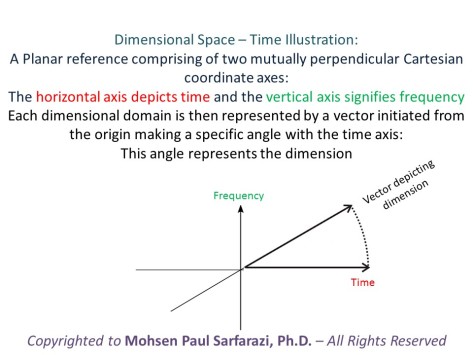
- Since space (or frequency) represents an inverse function of time, we can write:
ω(t) = 1/t
- If we consider the plot of frequency (representing space) versus time (see Figure below), we see that it is possible to distinguish among various regimes residing in the time-space continuum.
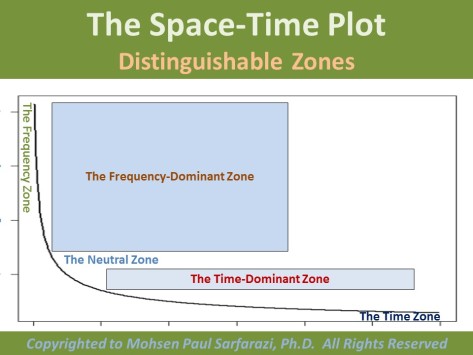
- On the extreme side one can define a ‘time zone’ that consists of the asymptotic portion of the curve with the time axis (close to the abscissa or time axis).
- This describes a domain in which the notion of time is very strong with little or no changes in frequency.
- Concentrating our attention on the physical planes, and particularly the 3rd dimension, it is clear how time is perceived to be linear in this dimension.
- Obviously in linearity, one concerns oneself with infinitesimal changes, so the progression of time is very slow, making the notion of time, and in particular the linear sequence of past, present, and the future quite prevalent and discernible.
- This presents a great venue for experimentation and learning as the time sequence progression is slow, affording observation in a frame-by-frame manner, so to speak.
- This by comparison to higher dimensions, is a kind of dilatational response, in which time progression becomes very slow.
- And, the situation is commensurate with the low inherent natural frequencies of the entities that dwell in such dimensions.
- Conversely, one can define a ‘frequency’ zone comprised of a domain in the vicinity of the space just off the ordinate axis.
- And, this consists of a regime in which the notion of time is extremely weak or almost absent while frequencies are changed drastically as one traverse from one dimension to another.
- Additionally, one can distinguish a ‘neutral zone’ in which the propensity for notion of time or space is equally viable.
- The ‘neutral zone,’ consists of the 45th dimension, in which both time and space measures become equally prevalent.
- It is very hard for us to decipher the ramification of such a time-space continuum, and thus no further elaboration can be made in this respect.
- And, between the extreme domains of time or frequency and the neutral zone there exists a range of dimensions in which either time or frequency is more pronounced.
- Above the neutral zone, the notion of time becomes highly insignificant.
- This may be defined as the ‘frequency-dominant’ zone.
- The continuums that lie in this region may be considered to be frequency-dominant dimensions.
- In the frequency dominant region (particularly those that lie above many lower dimensions), dimensional access and multidimensionality becomes very prevalent [11].
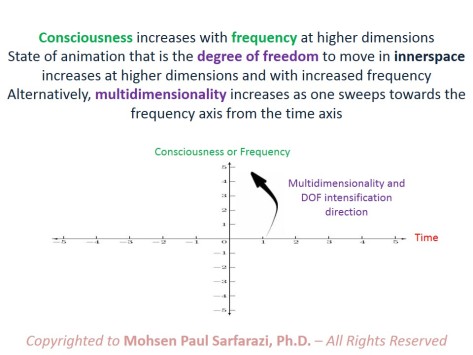
- On the other hand, below the neutral zone, the notion of time is strong.
- This may be defined as the ‘time-dominant’ zone.
- The time-dominant regime describes lower dimensions in which the frequencies are low, yet the time is very discernible.
- Among the continuums that encompass this regime are those dominated by physicality (dimensions 1 to 12).
- In particular, in the first three dimensions, designated as pure physicality, the progression of time is quite dominantly discernible but the frequencies are extremely low in comparison.
- This is the regime in which matter is prevalent over antimatter.
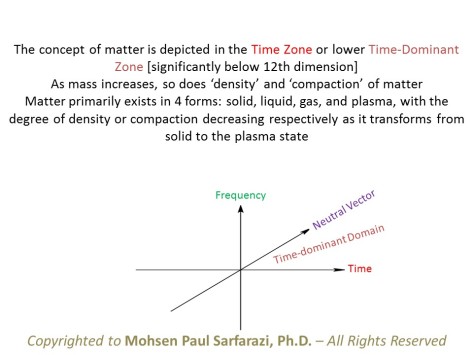
- In contrast, as the dimensional number increases matter becomes scarcer, and more antimatter comes to be.
- For dimensions beyond 12, everything turns out to be of pure antimatter.
- Note that in extreme low dimensions (e.g., 1 to 3), the notion of time becomes very infinitesimal as access to innerspace becomes problematic or challenging.
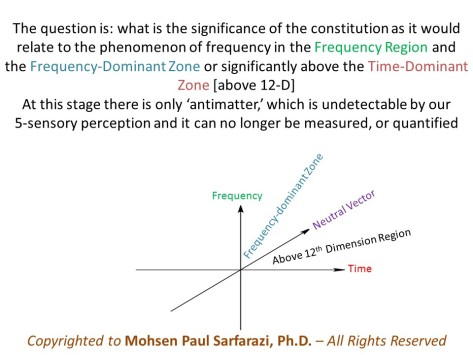
- This is the realm of low multidimensionality.
- Conversely, in the higher dimensions characterized by higher frequencies (which may be considered as a measure of space), the notion of time disappears (time progresses very quickly), and in contrast, dimensional access or multidimensionality becomes readily achievable.
- These could be classified as the ‘frequency-dominant region.’
Classification of the Time-Space Quadrants
- Four distinct quadrants may be identified in such a graphical illustration of dimensions or time-space continuums.
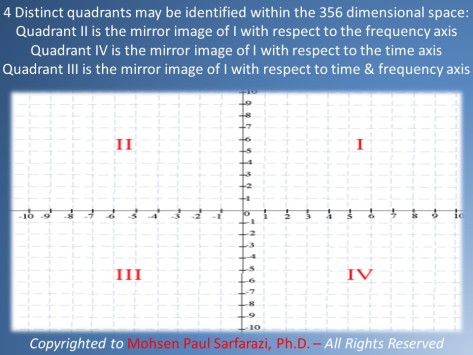
- Quadrant I is comprised of a domain in which both time and space measures are positive.
- In quadrant II, the space measure is positive but time is measured as a negative quantity.
- Quadrant III characterizes a realm that both time and space measures are negative.
- Finally, in quadrant IV, time measure is positive yet the quantity depicting space is negative.
- It is clear that in each quadrant, it is possible to distinguish among a total of 89 distinct dimensional planes if we designate an integer to depict a particular time-space continuum.
- Thus, it is possible to define a total of 4 x 89 = 356 dimensions arranged consecutively from one time-space continuum to the next.
- Note that quadrant II represents a domain in which the quantity denoting space (frequency) is identical, yet time is negative.
- In quadrant IV, however, the opposite is true, meaning that space is inverted upon itself (180 degrees phase difference) yet the time measures are positive.
- As for quadrant III, both time and space measures are negative.
- Clearly, quadrant III depicts a situation where everything is a mirror image of an counterpart in the quadrant I with respect to both time and space measures.
- In contrast, quadrants II and IV depict inversion with respect to one measure of time-space only, either time (quadrant II) or space (quadrant IV).
- When one considers the mirror image of one measure or another, it is said that a ‘conjugate’ or a ‘parallel’ counterpart is encountered.
- Therefore, each situation has 3 other counterparts: a mirror image with respect to either time, or space measures, or both.
- So, in essence, one only needs to consider a single quadrant (e.g., the first) as the other three are mere mirror images with respect to time, space, or both.
- Concentrating our attention on the first quadrant, again, it is clear that the time and space measures are inverse of one another.
Institute of Spiritual Science Inc. Publishing 2016.
All Rights Reserved.
No part of this article may be fragmented or copied without a written approval by the author.
This article may be shared or posted on websites, Facebook pages or any public forum only in its entirety, and only if it is offered free of charge to the public without any page charges, download fees, or membership charges.
Reference
- Mohsen Paul Sarfarazi, Ph.D., Dimensions of Consciousness Multidimensional Consciousness, wordpress.com
- Mohsen Paul Sarfarazi, Ph.D., The Time-Space Continuum Quantum Micro Mechanics of Cosmos, wordpress.com
- Mohsen Paul Sarfarazi, Ph.D., Soul-Body Vibration Quantum Micro Mechanics of Cosmos, wordpress.com
- Mohsen Paul Sarfarazi, Ph.D., A Mathematical Model for the Quantification of Consciousness [Soul Animation]Multidimensional Consciousness, wordpress.com
- Mohsen Paul Sarfarazi, Ph.D., On Quantification of Consciousness Multidimensional Consciousness, wordpress.com
- Mohsen Paul Sarfarazi, Ph.D., A Theory of Everything: Matter – Antimatter Quantum Micro Mechanics of Cosmos, wordpress.com
- Mohsen Paul Sarfarazi,, Ph.D.,A Mathematical Model for the Physical Vibration [Animation] of an Ageing Sentient Body Quantum Micro Mechanics of Cosmos, wordpress.com
- Mohsen Paul Sarfarazi, Ph.D., The True Meaning and Purpose of Karma Spiritual Science 101, wordpress.com
- Mohsen Paul Sarfarazi, Ph.D., Anxiety Spiritual Science 101, wordpress.com
- Mohsen Paul Sarfarazi, Ph.D., Fundamental Laws of Cosmos Inter-relating Consciousness, Constitution [Matter-Antimatter] and Energy Quantum Micro Mechanics of Cosmos, wordpress.com
- Mohsen Paul Sarfarazi, Ph.D., Multidimensional Vibration of Soul Aspects Quantum Micro Mechanics of Cosmos, wordpress.com